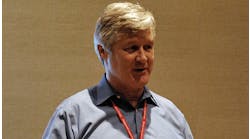Energy storage takes centerstage for Honeywell and customers
“Energy storage and digitalization are essential for enabling the modern grid.” Honeywell’s Prudence Hoffman recommends that each user configure available solutions to whatever degree and in whatever configuration makes the most sense for them.
Energy storage in the past? Just have the accountants pay the electric bill on time. Energy storage now? Let’s look “behind the meter” and adopt a combination of suitable options to save power and revenue, improve sustainability and gain other benefits.
Prudence Hoffman, interim general manager and technical leader, Energy Storage team, Honeywell Process Solutions, detailed several trends driving commercial and industrial (C&I) consumers to refocus on energy storage and reexamine their options, including how digitalization can help. These trends include:
- Looming climate crises due to global warming and how net-zero targets by government and business can aid prevention;
- Growing demand for renewables and clean energy sources by decarbonizing C&I companies, utilities, transportation providers and other sectors; and,
- Increasing need for flexibility to coordinate greater use of renewable sources, decreasing use of synchronous machines on the grid, and allowing greater use of alternative models that allow C&I users more resilient energy solutions and utility providers more flexible service options.
“The cost of lithium-ion (Li-ion) batteries has declined over the past 10 years, and other battery technology are gaining traction, especially for longer-duration solutions,” said Hoffman. “Just as software is the key to unlocking flexibility and value from assets, controls and remote operations are key to energy storage and sustainability.”
To demonstrate its own sustainability commitment, Hoffman added that Honeywell pledged to be carbon neutral in all its operations and facilities by 2035. In fact, it’s already reduced its greenhouse gas (GHG) emission by 90% since 2004, conducted 5,700 sustainability projects since 2007, and 50% of its R&D is focused on solutions for improving environmental and social outcomes. “When it comes to sustainability, we’re also our own customer,” added Hoffman.
Hoffman and Paul Vellacott, senior global offerings manager, Energy Storage, Honeywell, presented “Energy Storage Use Cases for C&I Users” this week at the Honeywell Users Group (HUG) Americas 2022 in Orlando, Fla.
Well-suited storage remedies
To help users determine the most suitable combination of power storage and support solutions for their processes and facilities, Hoffman and Vellacott presented a series of typical challenges and remedies, including:
- For poor power quality from the grid that can hinder operations—improve stability with Honeywell’s Battery Energy Storage System (BESS) and Energy Management System (EMS);
- To cut emissions in support of environmental sustainability goals (ESG) and net-zero targets—implement renewable assets, such as photovoltaic (PV) solar generation assisted by BESS and EMS;
- For increasing energy bills—reduce grid impact and shave peak-usage charges by adopting renewables like solar with BESS and EMS, which can help send power back to the grid and often produce revenue;
- To manage diesel generation, combined heat and power (CHP), solar and other alternative energy sources onsite—replace or supplement costly generation methods like diesel and gas, again with renewables, BESS and EMS;
- For increasing use of electric vehicles (EV)—manage and optimize EV charging infrastructure with a vehicle-to-grid (V2G) program, which likewise can be enabled by BESS and EMS;
- To address grid constraints impacting user operations and expansion plans—avoid costly reinforcement of traditional infrastructure with BESS and EMS; and,
- For handling energy efficiency of buildings and sites—implement building management systems and optimization software that can improve energy and demand management.
“Energy storage and digitalization are essential for enabling the modern grid,” explained Hoffman. “The best way is for each user to configure these available solutions to whatever degree and in whatever configuration makes the most sense for them.”
For instance, Canada-based Aypa Power recently implemented several turnkey BESS units and a remote operations center (ROC) managed by Honeywell for its 90-MW/180-MWh energy services business at multiple sites in southern Ontario. The project also included a KPI-based performance contract, predictive analytics for maintenance, mobile access control for digital voltmeters (DVMs), and asset management and peak prediction services. “Aypa is providing energy as a service (EaaS) to users to reduce their peak electricity costs by supplying power from their onsite BESS,” added Hoffman.
Put the pieces together
Vellacott reported that Honeywell’s energy storage solutions are organized into three main areas, including:
- Integrated BESS and controls available in Li-ion and non-Li-ion versions, multiple container sizes with fire and gas detection, and autonomous controls. Li-ion works best from 0.5 to 4 hours, while non-Li-ion work best from 4 to 12 hours;
- Experion Energy Control System monitors, controls and provides integrated views of assets, software for peak prediction, frequency regulation and planning/autonomous dispatch, along with a ROC; and,
- Virtual power plant (VPP) advanced control software that aggregates and deploys energy storage units, as well as allowing users to participate in energy markets and create added revenue streams.
“Our BESS, Experion EMS, ROC, operations and maintenance (O&M), EaaS and resilience as a service (RaaS) programs are also organized within Honeywell’s Microgrid Solutions program,” added Vellacott. “For example, an application with a hybrid, 1.7-MW PV system, 1-hour BESS and EMS was installed at our gas detector manufacturing facility in Lugoj, Romania. It reduced the plant’s carbon emissions, cut its electric bill by 30%, and established a 10-year payback period by reducing reliability issues.”
To implement an energy storage system, Hoffman reported that Honeywell’s Energy Storage team typically consults with clients to understand their needs, performs an energy audit and site assessment, and develops business cases and a conceptual design. Next, they complete a full system design for BESS, controls and other components, install BESS, PV and EV devices, and integrate the site with its EMS, VPP and microgrid solutions. Finally, after the energy storage system is in place, the team arranges for long-term O&M, remote monitoring, warranty and performance guarantees packages.
“Honeywell likes long-term relationships, so we also develop energy performance contracts for the long haul,” concluded Hoffman. “Some users like to manage their own energy storage system, while others need help in some areas, and some want us to do it.”
The editors of Control, Control Design and Smart Industry are reporting live from 2022 Honeywell Users Group in Orlando, Florida, to bring you the latest news and insights from the event. When the event comes to a close, the best, most important coverage will be compiled into a report by the editors.
Register now to pre-order the report and be among the first to receive it in your inbox.






